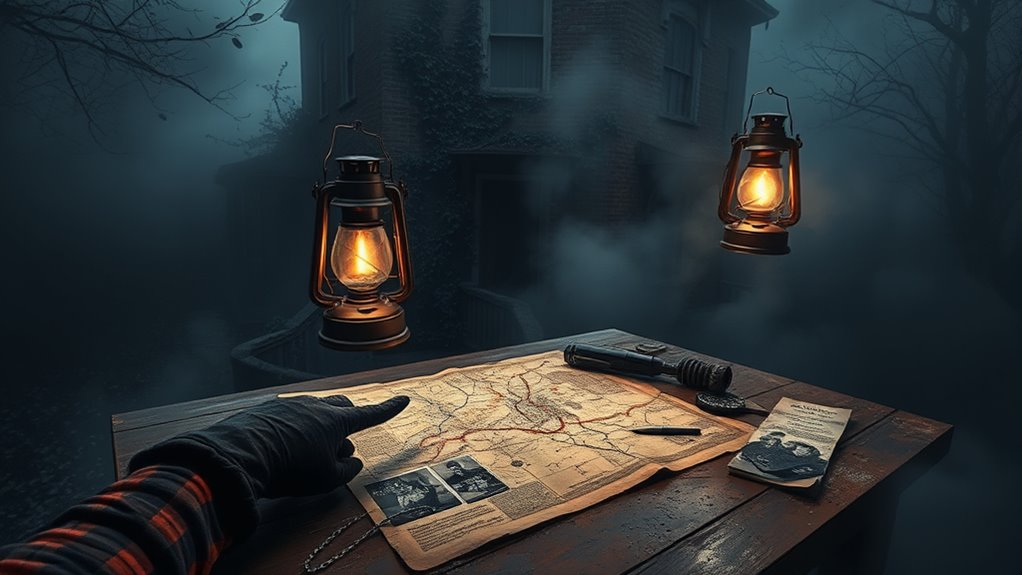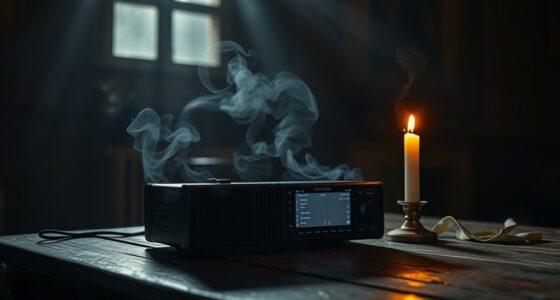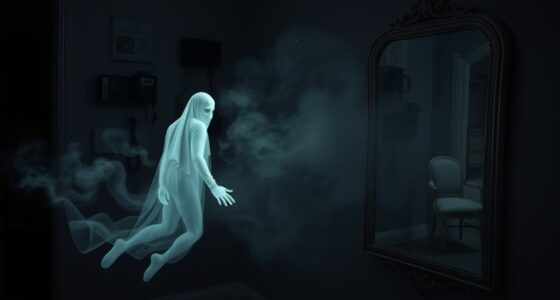To research haunted locations, start by examining historical records like old newspapers, property deeds, and court documents to establish a factual timeline. Explore local legends and folklore, which often carry kernels of truth and add cultural context. Cross-reference these stories with concrete data such as census data and oral histories to verify patterns like tragic events or violence. Combining these sources helps uncover the real stories behind the spooky reputation—if you keep exploring, you’ll discover even more intriguing details.
Key Takeaways
- Gather and analyze historical records like birth, death, property deeds, and court documents to establish factual timelines.
- Collect local legends and folklore to understand cultural narratives and identify recurring ghost stories or supernatural claims.
- Cross-reference multiple sources such as newspapers, census data, and oral histories to verify facts and identify patterns.
- Incorporate historical context to connect legends with real events, societal influences, and why sites gained haunted reputations.
- Combine factual evidence with storytelling to create a comprehensive, layered understanding of haunted locations and their histories.

Have you ever wondered what makes a location haunted? Often, the answer lies buried in the past, hidden within historical records and local legends. When you begin researching haunted spots, you’re fundamentally piecing together a story that spans decades, even centuries. Historical records are invaluable because they provide factual details—birth, death, and event records, old newspaper articles, property deeds, and court documents—that help you establish a timeline of what actually happened in that place. These documents can reveal tragic events, crimes, or significant moments tied to a location, giving you a solid foundation of concrete evidence that supports its haunted reputation. But don’t overlook local legends; they’re the folklore that breathes life into these sites. Tales passed down through generations often contain kernels of truth, amplified over time, which can guide your investigation. These stories may describe ghost sightings, mysterious sounds, or unexplained phenomena, which, while not always verifiable, add a layer of cultural context to your research. Additionally, utilizing market research can help identify common themes or patterns in haunted locations, offering insights into why certain sites develop their spooky reputations.
When you dig into historical records, you’re likely to find patterns or recurring themes that reinforce the haunted reputation. For example, if multiple records mention tragic deaths or violent events at a specific site, it provides a plausible explanation for lingering spirits. Cross-referencing these records with local legends can help you identify whether stories are rooted in fact or just tall tales. Be cautious, though—legends can evolve, and some stories might be embellished or exaggerated over time. To get a clearer picture, compare different sources: old census data, property histories, newspaper archives, and oral histories collected from local residents. This multi-faceted approach helps you separate fact from fiction, giving your research credibility. Incorporating historical context is essential because it helps explain the origins of certain legends and their connection to real events or societal influences.
Keep in mind that local legends often contain emotional truths that aren’t documented officially but are deeply embedded in community memory. These stories can reveal how a place impacted those who lived there and why it might be considered haunted. Listening to residents’ recollections or reading about local traditions can enrich your understanding of the location’s haunted reputation. By combining the factual weight of historical records with the colorful, sometimes supernatural, stories of local legends, you create a thorough picture. This layered research not only enhances your knowledge but also deepens your connection to the site’s history and its ghostly lore. Ultimately, uncovering what makes a location haunted is about blending evidence with storytelling, and it’s your curiosity that drives you to explore every detail—past and present.
Frequently Asked Questions
How Do I Verify the Authenticity of a Haunted Location?
You verify a haunted location by researching its ghost stories and folklore legends. Look for credible sources, such as historical records or local archives, to back up the stories. Talk to locals or paranormal experts who have firsthand experience. Be skeptical of exaggerated tales and focus on consistent, documented accounts. Cross-referencing multiple sources helps you determine if the ghost stories hold any truth or are just legends.
What Are the Best Tools for Paranormal Research?
When it comes to ghost hunting, you need the right paranormal equipment to get accurate results. Essential tools include EMF meters to detect electromagnetic fluctuations, digital voice recorders for capturing EVPs, and infrared cameras for night vision. Using these, you can gather evidence during your investigations. Always remember to handle your paranormal equipment carefully, and stay open-minded while analyzing your findings to uncover the mysteries of haunted locations effectively.
Can Historical Records Confirm Paranormal Activity?
They say, “The truth is out there,” and in your search, historical records can help you find it. While they can’t definitively confirm paranormal activity, historical documentation can provide context and folklore verification, revealing patterns or stories that support sightings. Your research can uncover clues, but remember, ghosts often dwell in the domain of belief and speculation, making it a fascinating but uncertain pursuit.
How Do I Approach Local Authorities About Haunted Sites?
When approaching local authorities about haunted sites, you should focus on community engagement and respect for legal considerations. Start by explaining your interest and gather community support to show the site’s significance. Be transparent about your intentions and follow any regulations or permits required. Respect their authority, listen to their advice, and maintain a professional attitude to foster cooperation and ensure your investigation complies with local laws.
What Safety Precautions Should I Take During Investigations?
Remember, safety first! When investigating haunted locations, always prioritize personal safety and equipment safety. Wear sturdy footwear, bring a flashlight, and have a first aid kit on hand. Use reliable recording devices and avoid risky areas like unstable floors or hidden holes. Stay alert, stick with your team, and trust your instincts. Taking these precautions guarantees you enjoy your exploration while minimizing dangers along the way.
Conclusion
As you explore haunted locations, remember that each ghostly tale is a thread in a rich tapestry of history and mystery. Your curiosity acts as a lantern, illuminating secrets long buried. Don’t just wonder from afar—step into the shadows and uncover the stories waiting to be told. After all, isn’t it the unknown that keeps our spirits restless and our minds enthusiastic? Embrace the thrill, and let the past whisper its secrets to you.









